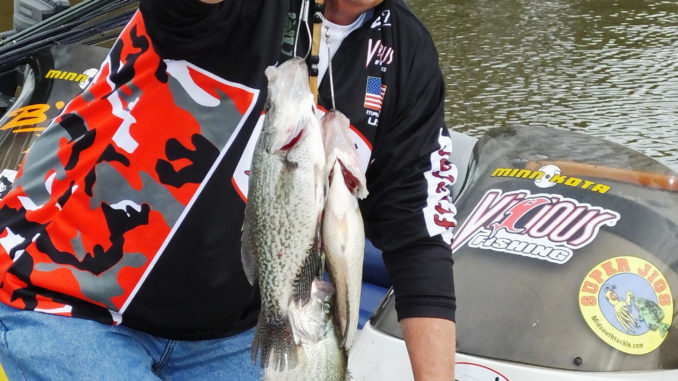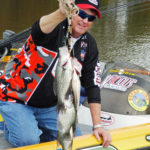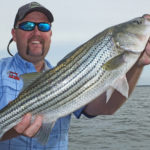
Legislators getting ready to approve new limits
Restoring the striped bass fishery on the Santee Cooper lakes with the 26-inch size minimum,a three-fish creel limit, and closed summer season was the goal of a seven-year plan formulated by the Santee Cooper Striped Bass Stakeholders Committee and the S.C. Department of Natural Resources.
Santee Cooper’s striper population has boomed in recent years, and the Stakeholders Committee and SCDNR have carefully developed a new plan to meet future goals: to enable fishermen to better utilize the resource while maintaining the population’s improved age structure.
Scott Lamprecht, a fisheries biologist with the SCDNR based in Bonneau, said the plan is a win-win for striped bass and anglers.
“The proposal allows for a 23- to 25-inch harvest slot limit for keeping stripers, while maintaining the three-fish creel limit,” Lamprecht said. “This is very similar to how spot-tail bass have been successfully managed on the marine side.
“The Santee Cooper lakes currently have an abundance of fish in this slot length for anglers to keep. It would enable the fish larger than that to stay in the system to provide natural recruitment. Modeling studies show this structure would keep the benefit of the 26-inch minimum while enabling anglers to put more fish in the cooler.”
Lamprecht said the proposal would also extend the fishing season until June 15. The current regulations close the season June 1 and re-open it Oct. 1. The opening date in the fall would remain the same.
“The goal of rejuvenating the striper fishery has been successful,” Lamprecht said. “This change allows anglers to harvest more fish of a respectable size while enabling the population to sustain and grow. The legislation in its current form allows the retention of one trophy fish in excess of 36 inches (long) as part of the three-fish limit.
“The success of any length limit is highly dependent on fish handling,” Lamprecht said. “Careful handling is essential to released striped bass survival.”
Lamprecht said when fishing is fast and furious, as it was in the fall of 2015, it may be time to consider using barbless hooks and long, de-hooking pliers to minimize handling and out-of-the-water time.
As of early April, the legislation has passed the S.C. House and is in the Senate. Lamprecht said bills of this type typically take effect July 1, or upon signature of the governor. It is very possible that the new regulations will go into effect to impact the next license period, the 2016/2017 cycle.
Regardless of future regulatory changes, striper fishing this month will be under the current regulations, and typically, May is a prime month for catching lots of stripers and a reasonable expectation of catching a few keeper-sized fish of 26 inches or larger.
By May, many stripers have migrated back down from the annual spawning journey and will be found throughout Lake Marion and Lake Moultrie. Most of these fish will be suspended over deep water, and vertically fishing live bait, primarily herring, will be the most-productive method.
This is still a good time to find fish in the river portion of upper Lake Marion; many fish are still moving back down the rivers. The Pack’s Flats and the Santee River from the confluence of the Congaree and Wateree rivers down to the I-95 bridge can be very productive. Live bait is still the most dependable bait to entice a bite, but a few fish can still be caught on cut bait. Striper fishing will also be very good in the Diversion Canal.
Fishing for largemouth bass should be excellent, with topwater action booming. Many of the largest bass will have spawned, but plenty of big-fish opportunities exist. Buzzbaits, Pop Rs and Baby Torpedoes are prime lures. Also, bottom-bumpers such as soft-plastic creature baits, worms and large spinnerbaits will catch big fish. On points and stumpy flats, crankbaits that dive in the 4- to 8-foot range will be productive early and late in the day.
Crappie action is excellent, with plenty of slabs being taken, but most crappies are now in or headed to deeper water. Brush piles are great, and 12 to 22 feet of water is a good depth range. As the month progresses and the water warms, fish tend to move deeper in Lake Moultrie, preferring to hold tight to man-made or natural cover along drops and ledges.
As crappies make their way back toward deeper water and cover, anglers will likely have to move frequently to stay on fish. By late May, they will begin to settle into more predictable, deeper areas. But when you find crappies in the mid-depths during this May migration you can catch a sackful of slabs.
May is also prime time for shallow-water bream and shellcracker fishing. Bream will be bedding throughout both lakes; look for fish in very shallow water down to 3 to 4 feet. Most anglers work along the shallow cover of trees and weed lines and use crickets to probe potential hot spots. Crickets are superb for bream and will catch shellcrackers. Have red worms handy if you catch a shellcracker, because this is a great time for these big panfish.
Catfish action is excellent in both lakes; they will be found in just about all depths of water — very shallow to very deep. Most big, blue catfish will have already been to the shallows, but a few will linger, and after-dark is a very good time to find big blues still feeding in shallow water. Cut herring, shad and white perch are all excellent baits. Flathead action is also good, and live offerings will be tops for catfish.







Be the first to comment